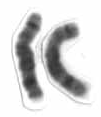
Photo from wikipedia
Charcot–Marie–Tooth disease (CMT) is the most common hereditary peripheral neuropathy. Mutations in the neurofilament light polypeptide (NEFL) gene produce diverse clinical phenotypes, including demyelinating (CMT1F), axonal (CMT2E), and intermediate (CMTDIG)… Click to show full abstract
Charcot–Marie–Tooth disease (CMT) is the most common hereditary peripheral neuropathy. Mutations in the neurofilament light polypeptide (NEFL) gene produce diverse clinical phenotypes, including demyelinating (CMT1F), axonal (CMT2E), and intermediate (CMTDIG) neuropathies. From 2005 to 2020, 1,143 Korean CMT families underwent gene sequencing, and we investigated the clinical, genetic, and neuroimaging spectra of NEFL‐related CMT patients. Ten NEFL mutations in 17 families (1.49%) were identified, of which three (p.L312P, p.Y443N, and p.K467N) were novel. Eight de novo cases were identified at a rate of 0.47 based on a cosegregation analysis. The age of onset was ≤3 years in five cases (13.5%). The patients revealed additional features including delayed walking, ataxia, dysphagia, dysarthria, dementia, ptosis, waddling gait, tremor, hearing loss, and abnormal visual evoked potential. Signs of ataxia were found in 26 patients (70.3%). In leg MRI analyses, various degrees of intramuscular fat infiltration were found. All compartments were evenly affected in CMT1F patients. The anterior and anterolateral compartments were affected in CMT2E, and the posterior compartment was affected in CMTDIG. Thus, NEFL‐related CMT patients showed phenotypic heterogeneities. This study's clinical, genetic, and neuroimaging results could be helpful in the evaluation of novel NEFL variants and differential diagnosis against other CMT subtypes.
Journal Title: Molecular Genetics & Genomic Medicine
Year Published: 2022
Link to full text (if available)
Share on Social Media: Sign Up to like & get
recommendations!